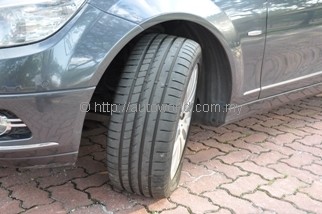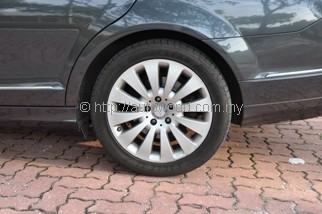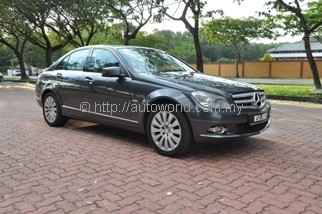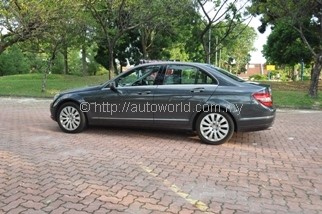Goodyear Eagle F1 Asymmetric 2 Tyre – 10,000 km Test
I have just completed 10,000 kilometres of driving on the Goodyear Eagle F1 Asymmetric 2 tyres, and I must say that it is a great tyre. I cannot say that it is the best tyre, because different applications require different types of tyres, but based on the car that it was fitted on, it would be one of the best that you can get. In this case, the Goodyear Eagle F1’s were fitted onto a Mercedes-Benz C200 Kompressor (204 model), a daily driver that does a lot of long distance drives, with a high percentage of this driving done at very high speeds, in addition to the normal puttering around town driving.
Where high speed driving is concerned, the things that matter the most, at least to me, would be the straight line stability, cornering ability, and wet grip. Other factors that matter would be tyre noise, to a lesser degree, fuel consumption, and tyre wear. One other factor not normally taken into consideration on long drives would be the performance of the tyres after a long drive at high speeds – the tyre temperatures would have gone up considerably, and if they go up too high, then the cornering, braking and wear characteristics deteriorate.
I would have liked to test the tyre a lot longer before I wrote this report, so I could tell you how it performs at half-life and beyond, but after 10,000 kilometres, the wear is still minimal, as you can see from the photos taken, so I thought I should get down to it now rather than wait. From the wear pattern, and the fact that the tyre shoulders are not scrubbed at all despite all my high speed manoeuvres, I would expect that this set of tyres should be able to yield at least 50,000 kilometres of driving before the tread wear indicators show me that it is time for replacement, and this is a conservative estimate. People who drive at the normal ‘sane’ regulatory speeds should be able to get another 20,000 kilometres more.
For the uninitiated, the tyre shoulders would be the first areas to show wear and tear in conditions of extreme usage, such as in high speed cornering – the outer edges start to become very ‘rounded’ and in really extreme cases, you will see some ‘fraying’ of the rubber as a result of the sidewalls caving in under the heavy loading when the car is pushed to the limits. In the case of the Eagle F1 tyre, the designers seem to have minimised this by employing a cross-ply pattern for the reinforcements in the side wall construction. This helps the sidewalls to retain composure even during extreme stress – I assume that this is something the Goodyear people learnt from supplying F1 racing tyres. By mixing the cross-ply technology with that of a radial tyre, the Eagle F1 thus is really a ‘hybrid’ tyre of sorts. The benefit to the consumer is better consistency in terms of handling, and improved wear characteristics.
The asymmetric pattern, which means the outside tread and inside tread patterns are different, serves to improve the overall performance of the tyre. If you look at the tyre, you will find a more pronounced ‘block’ pattern on the outside, followed by four grooves, and the inner blocks with more small grooves cut into them. The large blocks on the outside provides more rubber in contact with the road during cornering to give you more grip, besides providing a relatively stiff block of rubber that is more resistant to deformation – rubber that deforms easily will result in relatively more unstable handling, or even cause under-steer. The centre grooves, which consist of two larger grooves in the centre and two smaller ones bordering them, are meant to direct water away to the rear of the tyre so that more rubber can be in contact with the road when driving in the wet. These parts of the tyre, as with all the other parts of the tyre that are grooved, normally called the ‘sea’ area, are the key to grip in the wet. All tyres are a compromise between ‘land’ area (the rubber in contact with the road), and ‘sea’ area – more ‘land’ area will provide better grip in the dry, whereas more ‘sea’ area will provide better grip in the wet – it is a matter of balancing between the two. Then there is the inner tread area, where there are more grooves cut into the rubber blocks – the direction they face (in this case, towards the rear of the tyre when the tyre rolls forward) determines where the water is squeezed out. The inner half of the Eagle F1 has more grooves, so that wet grip can be attained.
In terms of performance, I find the Eagle F1’s to be much improved over the previous set that I have been using. I am now able to maintain a higher speed through corners, and the high speed straight line stability has definitely improved.
At high speeds on the highway, the Goodyear Eagle F1 provides an ‘assured’ feel – you know the car is stable, and it does not ‘wander’ from side to side. This is probably due to the fact that the side walls are stronger and as a result the sidewalls do not ‘flex’ or deform too rapidly. With reduced sidewall flex, one would expect the ride to be a little harsher, but it is not the case here. Perhaps the ‘cross-ply’ construction contributes in this area. At low speeds, the tyres are relatively quiet, and there is enough flex to cushion away most of the small undulations in the roads.
I actually had opted for a tyre size of 235/45 R17, which is one size wider than the 225/45 R17 which was originally supplied with the car, which did improve the car’s handling, but the shoulders just could not take the punishment. With the Goodyears, the sidewalls have managed to keep their shape despite undergoing exactly the same treatment. In terms of wet handling, the Eagle F1’s are a definite improvement – I now have that additional sure-footedness that I did not have before with my previous set.
Under braking, the Eagle F1’s are good – at slow speeds, you would not notice any difference perhaps, but at high speeds, you can really tell. According to the information sheet supplied by Goodyear, the tyre blocks deform under braking to increase the area of contact, to provide a larger contact surface with the road. I also believe the stiffer sidewalls help to increase straight-line stability under braking.
In terms of tyre noise, the Eagle F1’s are definitely much quieter than the previous set I had on the car. I remember my wife telling me my car was noisy – with the new tyres, it seems to have gone away somewhat.
On long distance drives, say, from Petaling Jaya to Penang and back, the previous set of tyres I had on the car would go ‘soft’ from the constant high speed driving and the resultant higher tyre temperatures generated – with the Goodyears, the tyre temperature remains consistent, and performance at the end of the journey is as good as at the beginning.
Overall, I have nothing but good to say about the Eagle F1’s – I enjoy my car more now than ever, and although I have not really monitored it in detail, fuel consumption has not seemed to deteriorate – I am in the frame of mind to continue on the Eagle F1 when this set eventually wears out.





























